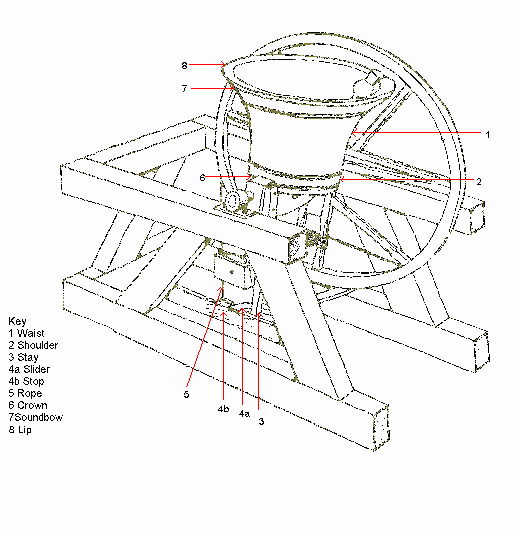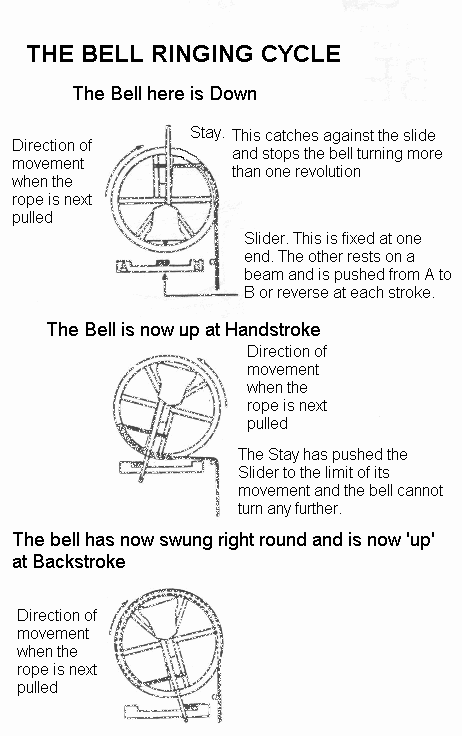© Parish of Hawley 2021



The Bells at Holy Trinity
The bells at Holy Trinity were replaced in 1992 due to the weight of the old set causing problems to the tower foundations.
We now have 8 bells set in the key F#, the tenor bell weighs 500kgs ( just over half a ton).
The bells are rung every Sunday at 10:30a.m, at Weddings and on special occasions.
Ringing Practice takes place on Tuesday evenings at 7:45 p.m. until 9:00 p.m. Extra tuition for beginners is available by arrangement.
The Tower Captain is Mr Richard Payne
Come and Join Us
Bellringing is a fascinating art or 'exercise' as bellringers call it. People interested in learning are always welcome to come to our tower at Holy Trinity. Once you can ring, even if not all that well, you will be made welcome at any tower you visit.
If you are in our area why not come along and give it a try.
The following information has been prepared by David Latter under the auspices of the Farnham District of the Guildford Diocesan Guild of Bellringers.
Acknowledgements:
Main Diagram A C D Mayes Central Council
Other Diagrams John Camp "Bellringing" Pub. David & Charles
How Ringing Started
Bells have been made for thousands of years and in all countries, but the 'ringing' of bells started in England, it is still rare outside of the United Kingdom. In this context the word 'ringing' has a special meaning. Bells can be made to sound by striking them from the outside, as in a clock, or by suspending them so that they can be swung from side to side; with a clapper inside to strike the bell. From this latter method ringing developed. At first, the bell was made to swing by means of a lever and a rope; but as early as the 14th century it was realised that by mounting the bell along with a section of a wheel, the rope being attached to its periphery, greater control over the bell could be attained.

The Stay and Slider
By the 17th century, the concept had reached the stage where a whole wheel was used, the rope running in a groove cut in its circumference. But although the control was greater, there was still no way in which the movement of the bell could be halted, except when it was pointing straight downwards.
What made it possible to halt the bell when pointing straight up - a development which led to the introduction of 'ringing' a bell through a full circle- was the invention of the stay and slider. The stay is a bar of wood that sticks straight up above the bell when it is at rest. When the bell is swung round so far that it points upwards, then the stay engages with the slider. This is a bar pivoted at one end and free to slide at the other between two stops. The stay pushes the slider over to a stop, and this allows the bell to turn just over its point of balance, but no further. It will then, if undisturbed, remain in that position; it is said to be 'up' or 'set'.
The following drawing should make this clear:

When the bell is swung round a full circle, so that it is pointing vertically up again, the stay pushes the slider over to the other stop, allowing the bell once again to go just beyond the point of balance, but tilted the other way.
'Raising' a bell means pulling on the rope to swing the bell through wider and wider arcs, until it can be set.
Ringing the Bell
When the bell is 'up' the rope, although it always hangs down in the same place, runs either under the wheel, or takes the longer way round, over the top, depending on which way the bell is set (see diagram). This means that the length of rope hanging down for the ringer to pull, is longer or shorter. In the first case the 'sally' ( the wool woven into the rope for about three feet) can be grasped, and this is called the hand stroke. In the second case only the tail end below the sally can be held, and this is called the back stroke.
Ringing starts with the bells set at hand stroke. Each bell is 'pulled off' over the point of balance, just hard enough to swing it right round to the point of balance again, facing upwards, and it is then gently checked with the rope. A pull at back stroke brings the bell round the other way, and the cycle may then be repeated.
The pull required is not all that great, even for quite a large bell. Indeed the most common mishap in ringing is for a beginner to pull too hard, sometimes so hard that the stay is broken. Then the bell continues to turn, winding more rope onto the wheel. The ringer has to let go pretty sharply, or risk being carried up to the ceiling of the ringing chamber.
In fact , good ringers check the bell just at, but not over, the point of balance, and so the stay and slider do not come into operation at all, except at the end of ringing, when the conductor calls 'stand', meaning; set your bells at the next hand stroke.
Ringing in Order
So much for the actual ringing of a bell; we now turn to the order in which the bells are rung. In a tower, there may be any number of bells up to 16, but 5,6,8,10 or 12 are the most common.
They are so arranged in the belfry that the ropes hanging down into the ringing chamber form a circle in descending order of the pitch of the bells they control; from the bell with the highest note( the 'Treble') down through 2,3,4 etc. to the bell with the lowest note (the 'Tenor'). Ringing bells in this order from treble to tenor is called ringing 'rounds', and this is how the ringing always starts.
However, by checking the bell slightly sooner or letting it swing a fraction further, a ringer can make the bell sound earlier or later by a small amount. This enables two bells to change places; if 2 and 3 changed places in this way, instead of rounds the order would become :- treble, 3,2,4,5 etc. Note no bell ever moves more than one place ( changing with the bell either just before of just after in the existing order) at any one blow, if the ringing requires this to be done.
Another important point, is that in order to make a bell ring in a particular place, it is no use the ringer waiting to hear the bell immediately previous , and then pulling. There is quite a time lag between the pull which starts the bell swinging, and the moment when the clapper hits the bell to make it sound. So a ringer has to watch when the other ringers pull, and time his or her own pull accordingly. The ability to see the order in which the ringers are pulling is called 'rope sight', and it is essential for good ringing.
Call Changes and Methods
Changes in the order of the bells can be brought about in two ways. The bells may be specifically 'called' to change places, the resulting order then continuing until a further call is made; this method is termed 'call changes'. Alternatively, a 'method' may be rung. This means that the bells change their order at every blow, according to a regular set pattern or system. So once the instruction is given to start ringing a method, nothing more need be said, for the pattern to be carried through to its completion. There are thousands of different methods; some such as 'Plain Bob' or 'Grandsire' are fairly simple, but others are of awe inspiring complexity.
Along with the name for the particular method, a second term is used to denote how many bells are involved:-
The methods on an odd number of bells are named according to the number of pairs that can change at any one blow. With 5 bells for example, two airs can change, while one bell rings again in the same place. If such a method is being rung on an even number of bells , the tenor rings last or 'behind' every blow.
Course, Extents and Peals
Once a method has been started, the bells go through the changes of that pattern, and then come back into rounds. This is called a plain course. However the order of the bells during a course can be varied by calling some bells to make a change in the normal pattern; these are called 'bobs' and 'singles'. By using them, the number of changes that occur before the bells come back into rounds, can be increased, making what is called a 'touch' as distinct from a plain course.
But however long the touch, the bells must finish in rounds; moreover there must be no repetition of any one order. The number of changes that can be made without such a repetition, is greater than you might think:
A 'peal' is the term use for all the possible changes (the extent) on 7 bells; but it also means any course of more than 5,000 changes. A peal takes about 3 hours to ring.
The Hawley Bellringing Team
|
No. of Bells |
4 |
5 |
6 |
7 |
8 |
9 |
10 |
11 |
12 |
|
Term Used |
Minimus |
Doubles |
Minor |
Triples |
Major |
Caters |
Royal |
Cinques |
Maximus |
|
No. of Bells |
3 |
4 |
5 |
6 |
7 |
8 |
|
Possible Changes (Extent) |
6 |
24 |
120 |
720 |
5,040 |
40,320 |
| Baptisms |
| Weddings |
| Funerals |
| HAMS |
| Mothers' Union |
| Bellringers |
| Trinity Hall |
| All Saints' Hall |
| Holy Trinity |
| All Saints' |
| Family History |
| Harriet Wyatt |